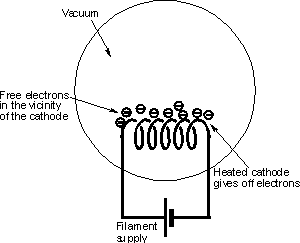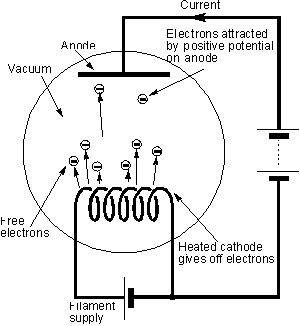Vacuum tube basic introduction
- the basic idea, concept and theory behind the vacuum tube or
thermionic valve
Thermionic valves or vacuum tubes come in many forms
including the diode, triode, tetrode, pentode, heptode and many more. These
tubes have been manufactured by the millions in years gone by and even today the
basic technology finds applications in today's electronics scene. It was the
vacuum tube that first opened the way to what we know as electronics today,
enabling first rectifiers and then active devices to be made and used.
Although vacuum tube technology may appear to be dated in the
highly semiconductor orientated electronics industry, many thermionic valves or
vacuum tubes are still used today in applications ranging from vintage wireless
sets to high power radio transmitters. However the most widely used thermionic
device today is the cathode ray tube that is still manufactured by the million
for use in television sets, computer monitors, oscilloscopes and a variety of
other electronic equipment.
Basics
The simplest form of vacuum tube is the diode. It is ideal to use this as the
first building block for explanations of the technology. It consists of two
electrodes: a cathode and anode held within an evacuated glass bulb, connections
being made to them through the glass envelope.
If a cathode is heated, it is found that electrons from the
cathode become increasingly active and as the temperature increases they can
actually leave the cathode and enter the surrounding space.
When an electron leaves the cathode it leaves behind a
positive charge, equal but opposite to that of the electron. In fact there are
many millions of electrons leaving the cathode. As unlike charges attract, this
means that there is a force pulling the electrons back to the cathode. Unless
there are any further influences the electrons would stay in the vicinity of the
cathode, leaving the cathode as a result of the energy given to them as a result
of the temperature, but being pulled back by the positive charge on the cathode.

Concept of thermionic emission
In a diode vacuum tube there is also another electrode called
the anode. If a positive potential is applied to this electrode, the electrons
will be attracted by this potential and will move towards it if it is at a
higher potential than the cathode.
For the optimum performance the space between the cathode and
the anode should be a vacuum. If there are any gas molecules in the space in
which the electrons travel, collisions will occur and this will impede the flow
of electrons. If an appreciable amount of gas is present, the electrons will
ionise the gas, giving rise to a blue glow between the electrodes. In the early
days of valves, it was thought that a certain amount of gas was necessary in the
envelope. Later this was discovered that this was not the case and new "hard"
valves were made that had a superior performance to the older "soft" valves.
Space charge
The electrons flowing between the cathode and the anode form a cloud which is
known as the "space charge". It can tend to repel electrons leaving the cathode,
but if the potential applied to the anode is sufficiently high then it will be
overcome, and electrons will flow toward the anode. In this way the circuit is
completed and current flows.
As the potential is increased on the anode, so the current
increases until a point is reached where the space change is completely
neutralised and the maximum emission from the cathode is reached. At this point
the emission can only be increased by increasing the cathode temperature to
increase the energy of the electrons and allow further electrons to leave the
cathode.

Concept of vacuum tube diode with cathode and anode
If the anode potential is reversed, and made negative with
respect to the cathode it will repel the electrons. No electrons will be emitted
from the anode as it is not hot, and no current flows. This means that current
can only flow in one direction. In other words the device only allows current in
one direction, blocking it in the other. In view of this effect, the inventor of
the diode vacuum tube, Professor Sir Ambrose Fleming called it an "oscillation
valve" in view of its one way action.
Control of current flow
Although the basic concept of the vacuum tube enabled a rectifier to be made, it
does not allow for another form of control of the flow of electrons in the anode
circuit. However it was discovered that is a further potential was placed
between the cathode and the anode this could be used to control the flow of
electrons between the cathode and anode. Once the theoretical idea was devised,
it was necessary to implement a way of placing this potential in the right
place. A n electrode known as a grid in the form of a thin mesh or wire through
which the electrons could pass, was inserted between the cathode and anode. It
was found that by varying the potential on the grid, this could alter the flow
of electrons. The grid is normally placed at a voltage below that of the cathode
so that it repels the electrons and counteracts the effect of the pull on the
electrons from the potential on the anode. If the voltage on the grid is varied
then it will vary or control the level of current flowing between the cathode
and the anode. As such this form of grid is known as a control grid. It makes
the vacuum tube into an active device that is capable of amplifying signals.
Further grids
The basic thermionic tube with three electrodes is called a triode in view of
the number of electrodes. To improve the performance of the tube, further grids
may be added. These tubes are given generic names that describe the number of
electrodes, and therby giving an indication of the type of tube and performance.
| Number of grids
|
Total number of
electrodes |
Generic name |
| 1 |
3 |
Triode |
| 2 |
4 |
Tetrode |
| 3 |
5 |
Pentode |
| 4 |
6 |
Hexode |
| 5 |
7 |
Heptode |
| 6 |
8 |
Octode |
Summary
The basic concept of the vacuum tube outlined here enables signals to be
rectified and amplified. Many refinements have been added in the form of further
grids to enable much better performance to be obtained, but the principles
involved are all the same.
|

